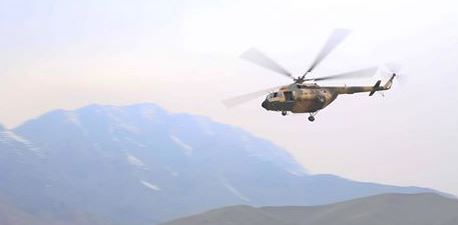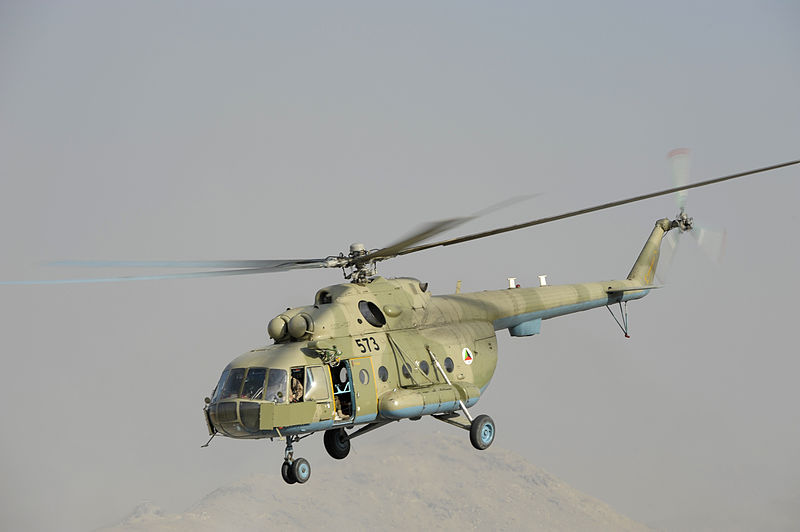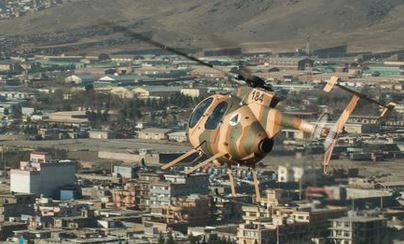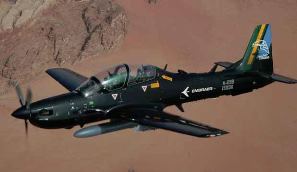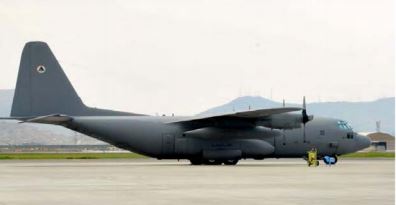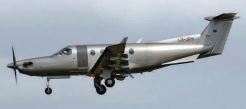 |
 |
||||
|
Menu HomeAfghan ReportDaily ReadKabul NEOMapsGlossarySite MapAdsThis website is an Amazon Associate and earns money for qualifying purchases.
(SidebarLeftAds) |
Afghan Air Force (AAF)"The Afghan Air Force is responsible for air mobility and close air attack in a country defined by large mountains in the north and wide-open plains in the south. Helping reach some of the most remote regions of Afghanistan, the AAF provides air assets for logistics, resupply, humanitarian relief efforts, human remains return (HeRo), casualty evacuation, non-traditional ISR, air interdiction, close air attack, armed overwatch and aerial escort". 23.
|
||||
|
Mi-35 Hind Helicopters |
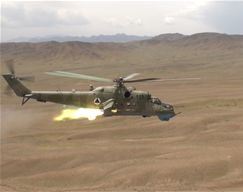 Mi-35 HIND Photo: USAF |
Mi 25 Attack Helicopters. India has provided the AAF with four Mi 25 helicopters. The first one arrived in December 2015 with three more delivered in January 2016.
Cheetal Light Utility Helicopter. India provided the AAF with three of the Cheetal Light Utility helicopers in 2015. They came with trained Afghan pilots and maintenance personnel.
UH-60 Black Hawk Utility Helicopter. The U.S. military plans to replace the aging Mi-17 utility helcopters currently in the AAF with the UH-60 Black Hawk. Over 159 UH-60s will be fielded to the Afghan Air Force over several years.
MD 530F Helicopters. The Afghan Air Force utilizes the MD-530F Little Bird helicopters for pilot training at Shindand Air Base in western Afghanistan. In addition, armed MD-530Fs provide close air attack and aerial escort capability. There should about (?) seventeen MD-530Ds in the AAF. Learn more about the AAF's MD-530F helicopter.
Photo by NATO - MD-530F flying over Kabul
A-29 Super Tocano. The Sierra Nevada Corporation, a U.S.-based firm, received in March 2013 a $427 million contract to provide 20 light-attack aircraft. The counterinsurgency planes, sometimes called a Light Air Support (LAS) aircraft, are being built by the Brazilian firm Embraer. The first A-29s arrived in January 2016. Learn more about the AAF's A-29 Super Tocano.
A-29 Super Tocano (Photo Embraer)
AN-32 Transports. In 2010 the AAF had at least four AN-32 transport aircraft. These have since been retired. Plans were that the AN-32s would be replaced with C-27s; but that didn't work out so well. 12.
C-27s Light Transport Planes. Approximately 16 C-27As bought and reconditioned by an Italian firm (Alenia Aeronautica) were in the Afghan Air Force; however, these planes were not used very much and many of them did not fly at all. ISAF stated that the C-27 program was discontinued in early 2013 due to maintenance, spare part shortages, and safety issues. Reportedly the Italian firm (and its subcontractor L-3 Systems Field Support) could not maintain the aircraft so 16 C-27s have been 'retired' and sat on pavement at Kabul airport for a few years before being destroyed and sold for scrap. Over $486 million was spent on the twin-turboprop C-27A program. The C-27As replaced a fleet of Antonov An-32 tactical transports - which apparently the Afghans did know how to fly and could maintain. Some reports indicate that the C-27A fielding fell apart because the Italians wouldn't pay outrageous bribes to high-ranking officials of the Afghan Ministry of Defense (MoD). Since the Italians wouldn't pay the bribes the Afghan MoD cancelled the contract. 13. Not a surprising development; as it is common knowledge that the Afghans have been stealing us blind. What is surprising is that the U.S. Air Force didn't step in to rescue the program. Instead the USAF thought that scrapping the aircraft and replacing them with the more complex C-130s was a better idea. (Naturally, this didn't work out so well either - read more below). In July 2014 the 16 aircraft were destined for the scrap heap and the dismantling process was started to get rid of the embarrassing spectacle of wasted money sitting on the ramp at the Kabul airport. 18. Reportedly, 16 of the 20 aircraft were sold to an Afghan scrap metal dealer for 6 cents a pound, or a total of $32,000. An investigation is being conducted by the Special Inspector General for Reconstruction of Afghanistan (SIGAR) to determine if any effort was made to salvage any of the aircraft parts (engines, instrumentation, etc.) prior to scrapping. In addition, SIGAR is inquiring into the disposition of four C-27As currently at Ramstein Air Base in Germany.
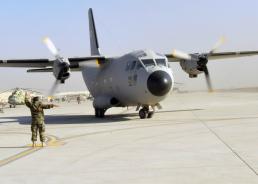 |
An Afghan Air Force member directs a C-27 Spartan on the flight line at the Afghan Air Force Base on the Kabul International Airport. (Photo by PO3 Jared Walker, 438th Air Expeditionary Wing, December 8, 2010). |
C-130H Cargo Planes. Since the Afghans couldn't manage to maintain the C-27s the U.S. Air Force decided to give the Afghans the more expensive and harder to maintain C-130. The U.S. Air Force has provided four C-130H cargo planes to the newly formed Afghan Air Force. Two of the large cargo transports arrived in the Fall of 2013, a third arrived in the fall of 2014, and the fourth arrived in June 2015. The fourth C-130 delivery was delayed; it seems the U.S. Air Force wanted to make sure the Afghans knew what to do with the first three before shipping the last one. Afghan crews have received training in the states. 10. It remains to be seen if the Afghans can maintain the C-130s; it didn't work so well with the C-27s. It is unclear why the Afghans didn't get the J model C-130s. There has been lots of questions about why the more expensive and harder to maintain C-130 were chosen to replace the C-27s. 16. A recent report by SIGAR suggested that the last (of four) C-130 should not have been delivered. 17.
Photo NATC-A, April 20, 2014
C-208B Cessna Caravan. A small prop aircraft used for basic aircraft flight training, light cargo lift, movement of personnel, non-traditional ISR, human remains return, and CASEVAC. The C-208 provides the capability to reach remote regions and landing on dirt runways. There are plans to have 25 C-208s in the inventory. See more on the C-208 at Wikipedia. 22. In January 2016 news reports indicated that the DoD approved a foreign military sale (FMS) of 18 x Cessna C-208B Caravan intelligence and reconnaissance (ISR) aircraft to support the Afghan Air Force. 29.
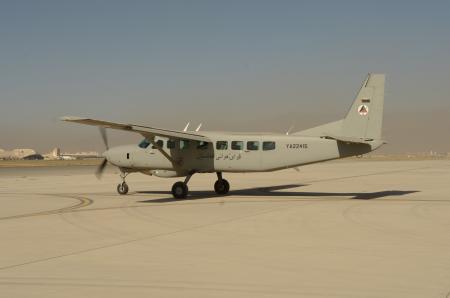
A Cessna 308 taxies down the flightline of the Kabul Air Wing Sept. 7, 2013. Afghan air force pilots assigned to the 373rd Fixed Wing Squadron marked the first all AAF fixed wing combat mission flown from the Kabul Air Wing. Their advisors assigned to the U.S. Air Force, 538th Air Expeditionary Advisory Squadron, of the 438th Air Expeditionary Wing worked with the AAF Cessna 308 pilots as Coalition Forces draw down and Afghanistan builds up their air force. (U.S. Army photo by Staff Sgt. Richard Andrade, International Security Assistance Force HQ Public Affairs)
Read more about the C-208 Cessna used by the Afghan Air Force.
PC-12 Aircraft. The AAF has a number of PC-12 aircraft. It is believed that the PC-12s belong to the Special Mission Wing. The PC-12s provide the SMW with an ISR capability that supports the Afghan Special Forces and Special Police Units. There are plans for up to 18 of the aircraft to be in the inventory. One news report says that the AAF currently has 17 of the PC-12s acquried under at $218 million contract. 27.
PC-12 (Photo
RS HQs)
F-35 Program Partner. Reports that the Afghan Air Force will receive the F-35 fighter are probably false; however this news release indicates that four of the new jets may have already been provided to the AAF.
Websites about the Afghan Air Force
Afghan Air Force by Wikipedia
http://en.wikipedia.org/wiki/Afghan_Air_Force
Afghan Air Force Facebook
www.facebook.com/AfghanAirForce
Integration Innovation, Inc. Provides Flight
Training at Shindand Airbase
www.i3-corps.com/its
Blog Posts on AAF by Afghan War News Blog
www.afghanwarnews.blogspot.com/search/label/Afghan-Air-Force
News Reports about the Afghan Air Force by
Afghan War News
www.afghanwarnews.info/air/news-reports-AAF.htm
Videos about the Afghan Air Force (AAF)
Afghan Pilots Launch on a Mission,
Resolute Support, September 5, 2017. AAF pilots prepare and arm their
helicopters for a mission in the Mazar-e-Sharif region.
https://www.youtube.com/watch?v=zbsOUyWwc1U
Taliban blow up helicopter using an IED inside
Afghanistan Army Base, posted on YouTube.com, April 15, 2016.
www.youtube.com/watch?v=dyuE-xOmISc
A Show of Strength by the Afghan National
Airforce, posted by Resolute Support on Youtube.com on February 12,
2016. A 1-min long video depicting the different AAF aircraft flying
during an AAF air show for President Ghani in Kabul.
www.youtube.com/watch?v=XrhOQfWL9n0
Pubs & Papers about Air Power and the Afghan Conflict
DoD IG, Progress of U.S. and Coalition Efforts
to Train, Advise, and Assist the Afghan Air Force, Department of
Defense Inspector General, January 5, 2018.
https://oversight.gov/report/dod/progress-us-and-coalition-efforts-train-advise-and-assist-afghan-air-force
Stubbs, Squadron Leader David. Afghanistan
Needs Our Air Power not Our 'Boots on the Ground', RAFCAPS Discussion
Paper No. 3, Royal Air Force Centre for Air Power Studies, 2010, page 7.
The author advances the argument that the Afghan military needed to train
personnel to conduct forward air control duties and to establish regional
Theatre Operations Centres.
www.afghanwarnews.info/pubs/AirPowerAfgStubbs2010.pdf
Videos about Afghan Air Force
May 26, 2014. "Afghan air force builds strength,
experience". NATO video posted on YouTube.
www.youtube.com/watch?v=2UzmKCYWRsk
October 3, 2013. "Three Mi-17 Helicopters
Delivered to Afghanistan". DoDLive. Video shows three helicopters
delivered to Kabul International Airport.
www.dodlive.mil/index.php/2013/10/three-mi-17-helicopters-delivered-to-afghanistan/
May 23, 2013. Afghans Receive New Mi-17
Helicopters. YouTube (courtesy NTM-A).
www.youtube.com/watch?v=nR79BeLI-uQ
December 6, 2012. "Speaking Russian helps Afghan
Air Force". NATO video posted on YouTube. AAF pilots build on their Soviet
legacy by using Russian language skills to work closely with their Czech
mentors for the Hind Mi-35 helicopter.
www.youtube.com/watch?v=oyVLTEddric
Endnotes
1. For a critique of the Afghan Special Operations Air Wing see "Afghanistan's Elite Air Force Can Barely Fly Its Own Planes or Use Night Vision Gear", Foreign Policy, June 28, 2013. Access the story here.
2. See a report by the Special Inspector General for Afghanistan Reconstruction (SIGAR) entitled Afghan Special Mission Wing: DoD Moving Forward with $771.8 Million Purchase of Aircraft that the Afghans Cannot Operate and Maintain, SIGAR Audit 13-13, June 2013. The report can be accessed here.
6. For more on Afghan Air Force running drugs see "Afghan Air Force Suspected of Drug Running: Report", ABC News, March 8, 2012 at this link and "Afghan Air Force: Flying Drug Mules That Fuel Civil War", Danger Room at Wired.com, March 8, 2012 at this link.
7. Info on class sent home for illiteracy is from Air Force MG H.D. "Jake" Polumbo (at one time the top U.S. air commander in Afghanistan; see "Afghan Air Force Waits on Light Attack Aircraft", Defense Tech, April 23, 2013 at this link.
8. Read more on the illiteracy problem in the ANSF in "If Afghan Troops can't read Cat in the Hat, this War is Screwed", Danger Room at Wired.com, August 23, 2010.
9. For more on the drug running by the AAF investigations see a story published by The Wall Street Journal - "Afghan Air Force Probed in Drug Running", March 10, 2012.
10. For more on the U.S. Air Force giving the Afghan Air Force four C-130H transports see "Afghans to receive first C-130 aircraft from US Air Force", Stars and Stripes, September 18, 2013.
11. For more on the ANAAC name change to AAF see Afghan National Army Air Corps now Afghan National Army Air Force, U.S. Air Forces Central Command, June 14, 2010. See story here.
12. See story - Afghan AN-32s Arrive, Defense Industry Daily, May 12, 2008.
13. See this story for more on the Afghan Air Force and corruption - "Greed and the Safer Aircraft", Strategy Page, January 14, 2013.
14. For numbers of aircraft in the AAF inventory (proposed) see "ISAF Air Training Commander Describes Delicate Balance", American Forces Press Service, September 20, 2013 at this link.
16. For more on the controversial decision to field the C-130s to the AAF see "US Special Inspector General questions C-130 deliveries to Afghanistan", Janes.com, 16 July 2014 at this link.
17. A recent investigation found that two C-130s were underutilized by 50% and when used only carried cargo and/or personnel that smaller aircraft could have carried (like the C27A). The report recommends that the last two (of four total) C-130s not be delivered to save money. See US Efforts to Stand-up Afghan Air Force Still Falling Down, Defense Talk, July 30, 2014 at this link.
18. For more on the scrapping of the C-27 fleet see "Afghan Air Force starts breaking up unwanted C-27As", IHS Jane's 360, August 13, 2014 at his link.
19. For more on ability of the Afghans to maintain the C-130 see "Gift Horses: Afghanistan's C-130 Fleet", Defense Industry Daily, July 16, 2014 at this link.
20. The first A-29 Super Tucano arrived at Moody AFB on September 26, 2014. So 13 years after we invaded Afghanistan and within months found ourselves fighting a counterinsurgency war we have the first COIN air platform ready to train some Afghan air crews. Great progress. See A-29 Super Tucano arrives at Moody AFB, U.S. Air Force News, September 26, 2014 at this link.
22. For more info on the Cessna Caravan C-208 see "This Tiny Plane is an F-16 for Cash-Strapped Air Forces", War is Boring, December 4, 2014. The Cessna Caravan is a transport, spy plane and attacker for small air arms.
23. Text in quotes take from a AAF trifold posted by Resolute Support
Headquarters on February 4, 2015.
www.rs.nato.int/images/media/PDFs/RSM/20150204_aaf_trifold_final.pdf
25. Some sources say there are only five Mi-35s in the AAF (or SMW) while others say eleven. What is certain is that on any given day there are probably less than four or five flying.
26. Numbers of aircraft taken from a variety of sources. A couple of
sources include Enhancing Security and Stability in Afghanistan,
DoD 1225 Report, December 2015 and Supplement to SIGAR's January 2015
Quarterly Report to the United States Congress, SIGAR, January 30,
2015. There are varying numbers of aircraft in the inventory - it all
depends on who your are listening to. ISAF (now Resolute Support) tends to
paint a rosy picture. Sometimes aircraft are counted in the inventory even
though they are non-functional. Some numbers reflect future deliveries of
aircraft in 2016, 2017 and 2018; so the numbers are quite misleading.
www.sigar.mil/pdf/quarterlyreports/Supplement_2015-01-30qr.pdf#page=17
26. Numbers of aircraft in the Afghan Air Force sourced from page 107 of
the Quarterly Report to the United States Congress, Special
Inspector General for the Reconstruction of Afghanistan, January 30,
2018.
www.sigar.mil/pdf/quarterlyreports/2018-01-30qr.pdf
For AAF training info see "Afghans want U.S. to speed up training of
Afghan air force", Air Force Times, March 26, 2015.
www.airforcetimes.com/story/military/2015/03/26/afghans-want-faster-training/70495180/
27. For more on the PC-12 see "Small spy planes make big difference on
Afghan battlefield", Stars and Stripes, September 26, 2015.
www.stripes.com/news/small-spy-planes-make-big-difference-on-afghan-battlefield-1.370538
28. As of November 2015 the AAF had four C-130s but only one C-130 flight engineer. Read more in "Lack of trained staff means long hours for Afghan air force engineer", Reuters, November 4, 2015.
29. See "Afghanistan to receive C-208B aircraft from Cessna", Airforce-Technolgoy.com, January 22, 2016. The contract is worth $55 million and will provide 18 more C208s.
30. Quote taken from page 3 of Enhancing Security and Stability in Afghanistan, DoD, December 2015. www.defense.gov/Portals/1/Documents/pubs/1225_Report_Dec_2015_-_Final_20151210.pdf
31. For more on numbers of aircraft during Soviet occupation see page 116
of the SIGAR Quarterly Report to Congress dated 30 April 2016.
www.sigar.mil/pdf/quarterlyreports/2016-04-30qr-section3-security.pdf#page=27
32. Read "Recruiting the Afghan Air Force - 'country's future'", DVIDS, August 1, 2016.
33. Read "Over 300 AAF personnel being trained abroad including India", Khaama.com.
Books about Afghanistan
All external sites open up in a new window.
Please report broken links or inaccurate content to the webmaster at
john @ north-point.org
© Copyright 2010-2025
